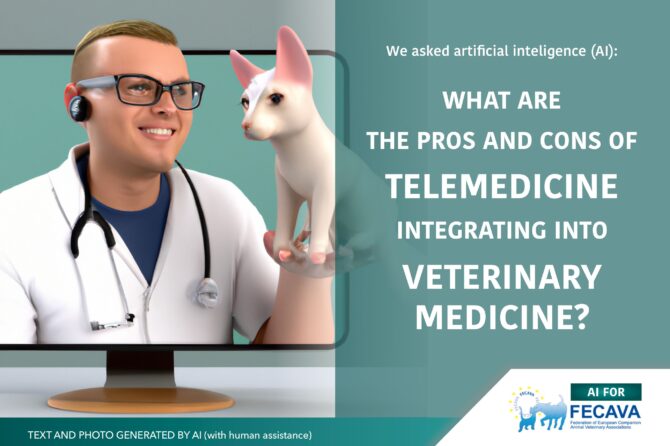
AI for FECAVA: Pros and Cons of Telemedicine Integrating into Veterinary Medicine
Telemedicine has been increasingly utilized across many healthcare sectors, including veterinary medicine. Like any innovation, it has both positive and negative aspects.
Positive Aspects:
1. Convenience: One of the major advantages is the convenience it offers to pet owners. They can consult with veterinarians from the comfort of their homes, saving travel time and reducing stress for pets that might not travel well.
2. Accessibility: It can improve accessibility to veterinary services, especially for people living in rural or underserved areas or those with mobility issues. This also extends to the ability to consult specialists who might not be locally available.
3. Efficiency: Telemedicine can help veterinarians manage their time more efficiently by reducing the number of non-urgent in-person visits and by allowing flexible consultation times.
4. Early Detection and Monitoring: With telemedicine, veterinarians can monitor patients’ conditions more frequently and spot potential issues early. This can be especially helpful for chronic conditions or post-surgery recovery.
5. Emergency Triage: In emergencies, telemedicine can allow vets to quickly assess the situation and provide first-aid guidance while the pet owner is en route to the clinic.
Negative Aspects:
1. Limited Physical Examination: Telemedicine relies heavily on pet owner’s descriptions and video feeds, which can be limiting. There’s no substitute for an in-person physical examination, especially for complex or serious conditions.
2. Technical Difficulties: Not all pet owners can access reliable internet or are comfortable using technology. There could also be challenges in capturing clear images or videos of the pet.
3. Misdiagnosis: The risk of misdiagnosis may increase due to the lack of a complete physical examination and potential misinterpretations of the pet’s behavior by the owner.
4. Regulation and Legal Considerations: The regulation around veterinary telemedicine still evolves and varies by region. There can be challenges related to licensing, liability, and defining a valid veterinarian-client-patient relationship.
5. Loss of Personal Connection: In-person visits can help strengthen the bond between the veterinarian, the pet, and the pet owner. This personal connection could be diminished with virtual consultations.
6. Inadequate Emergency Response: While telemedicine can provide initial guidance, it’s not equipped to handle emergencies that require immediate, hands-on care.
Overall, telemedicine can be a powerful tool for enhancing veterinary care when used appropriately and judiciously. As technology and regulations evolve, it will be crucial to address the challenges and maximize the benefits of this mode of veterinary care.
[Text and picture generated by AI: ChatGPT and DALL-E]
Leave a reply

Leave a reply